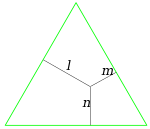Viviani's theorem: Difference between revisions
JohnWheater (talk | contribs) m →Proof: Clarify |
Geometryfan (talk | contribs) |
||
| Line 43: | Line 43: | ||
*[http://www.cut-the-knot.org/Curriculum/Geometry/Viviani.shtml Viviani's Theorem: What is it?] at [[Cut the knot]]. |
*[http://www.cut-the-knot.org/Curriculum/Geometry/Viviani.shtml Viviani's Theorem: What is it?] at [[Cut the knot]]. |
||
*[http://demonstrations.wolfram.com/VivianisTheorem/ Viviani's Theorem] by Jay Warendorff, the [[Wolfram Demonstrations Project]]. |
*[http://demonstrations.wolfram.com/VivianisTheorem/ Viviani's Theorem] by Jay Warendorff, the [[Wolfram Demonstrations Project]]. |
||
* [http://frink.machighway.com/~dynamicm/viviani-general.html Some generailizations of Viviani's theorem] at [http://dynamicmathematicslearning.com/JavaGSPLinks.htm Dynamic Geometry Sketches], an interactive dynamic geometry sketch. |
|||
[[Category:Polygons]] |
[[Category:Polygons]] |
||
Revision as of 20:51, 4 February 2012

Viviani's theorem, named after Vincenzo Viviani, states that the sum of the distances from a point to the sides of an equilateral triangle equals the length of the triangle's altitude.
The theorem can be extended to equilateral polygons and equiangular polygons. Specifically, the sum of distances from a point to the side lines of an equiangular (or equilateral) polygon does not depend on the point.[1]
Proof
This proof depends on the readily-proved proposition that the area of a triangle is half its base times its height.
Let ABC be an equilateral triangle whose height is h and whose side is s.
Let P be any point inside the triangle, and x, y, z the distances of P from the sides. Draw a line from P to each of A, B, and C, forming three triangles PAB, PBC, and PCA.
Now, the areas of these triangles are s*x/2, s*y/2, and s*z/2. They exactly fill the enclosing triangle, so the sum of these areas is equal to the area of the enclosing triangle.
So we can write:
s*x/2 + s*y/2 + s*z/2 = s*h/2
and thus
x + y + z = h
Q E D
Applications

Viviani's theorem means that lines parallel to the sides of an equilateral triangle give coordinates for making ternary plots, such as flammability diagrams.
More generally, they allow one to give coordinates on a regular simplex in the same way.
See also
References
External links
- Viviani's Theorem: What is it? at Cut the knot.
- Viviani's Theorem by Jay Warendorff, the Wolfram Demonstrations Project.
- Some generailizations of Viviani's theorem at Dynamic Geometry Sketches, an interactive dynamic geometry sketch.
